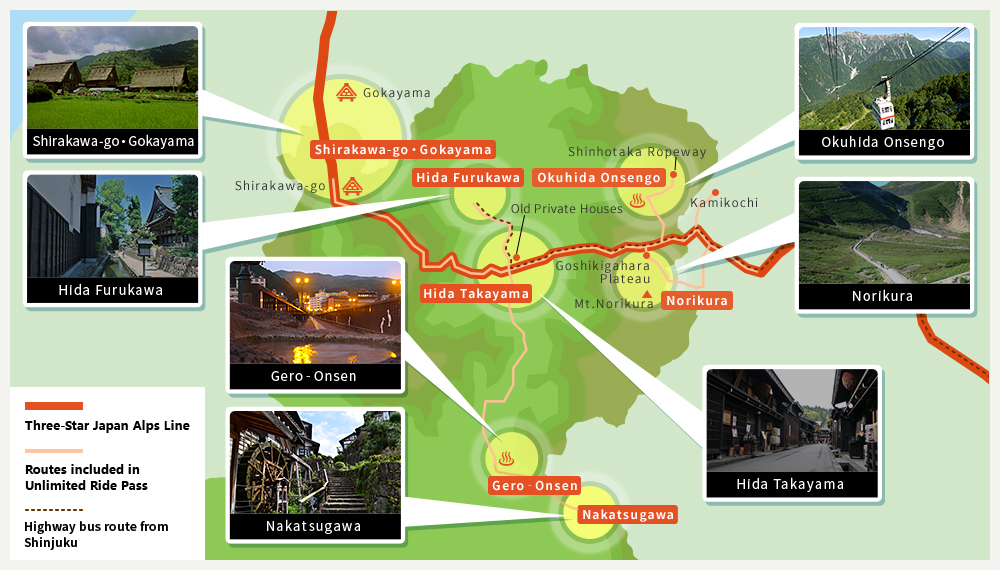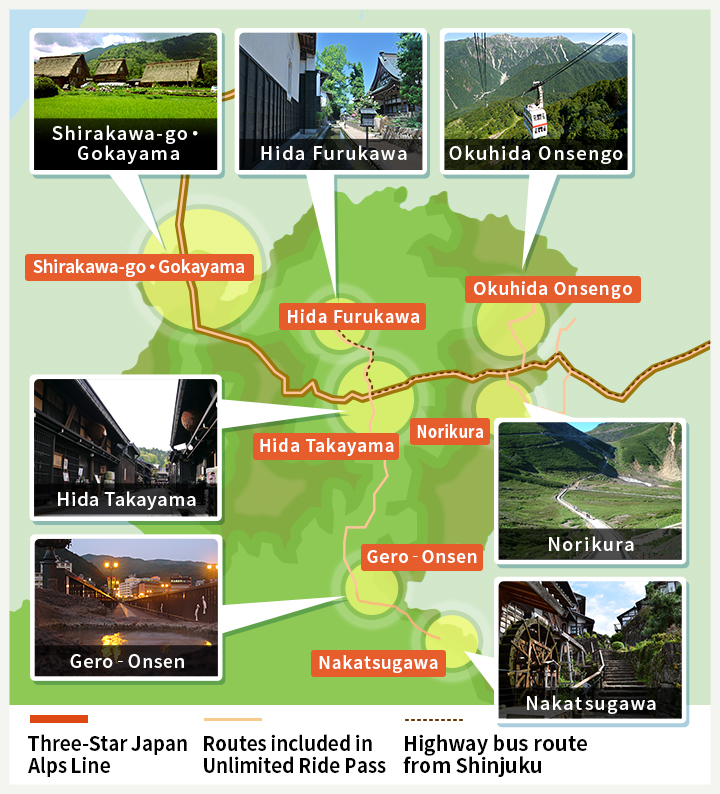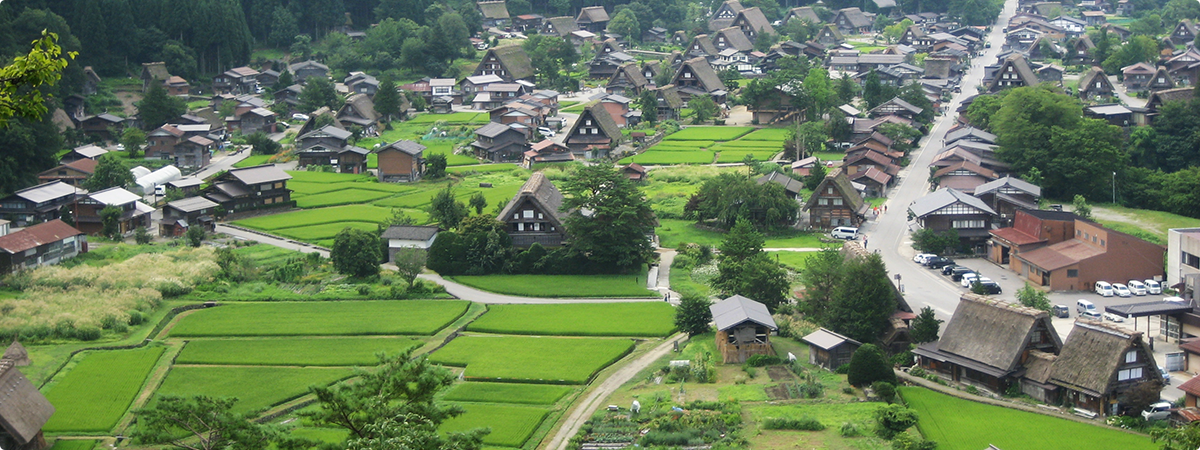
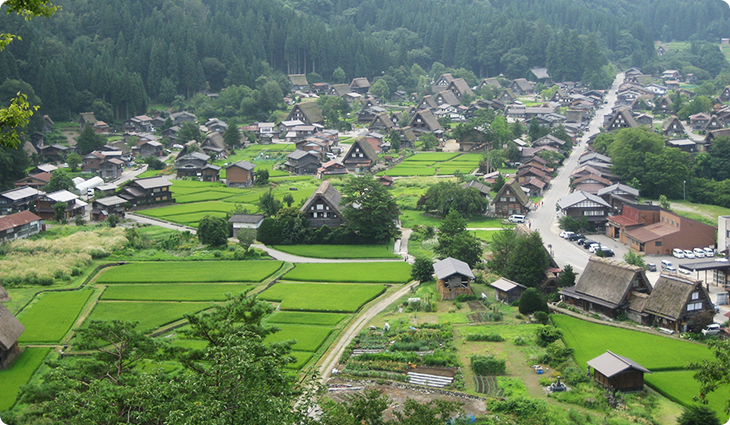
Tourist information on Hida Takayama・Shirakawa-go Area

This area is located in the northern part of Gifu Prefecture, and surrounded by mountains such as the Northern Alps. It has various tourist attractions in rich nature; Hida Takayama where the Edo period houses remain, the World Heritage Shirakawa-go / Gokayama with distinctive large roofed gassho style houses, Okuhida Onsengo where five unique hot springs exist at the foot of the Northern Alps, and Gero Onsen, one of the three major hot springs in Japan.
Hida Takayama
It is a popular tourist spot called “Little Kyoto in Hida”. The old townscape of the castle town and merchant town from the Edo period remains in the center of the city area. Many people visit from Japan and around the world.
From Shinjuku; take “Hida Takayama Line” on Chuo highway bus, get off at Takayama Nohi Bus Terminal
- Reservation for Highway bus “Hida Takayama Line” from here (Highway-buses.jp)
- Information about Route bus Takayama city line (Nohi bus)
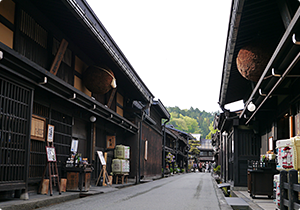
This district where the Edo period houses remain was designated an area of important traditional buildings by the Japanese Government. Miyagawa River is flowing nearby, and the bridge over the river creates a landscape with emotions.
【Access】Walk from Takayama Nohi Bus Terminal
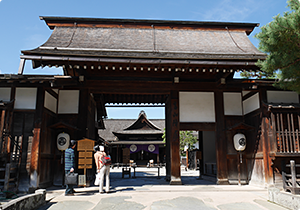
Takayama Jinya was a local governor’s office during the Edo period. There once were more than 60 similar buildings in Japan, however Takayama Jinya is the only one existing today. The present main building consists of the Public Administration Office, Grand Hall and Messengers Hall and the Rice Storehouse all in their original condition.
【Access】Walk from Takayama Nohi Bus Terminal or take Machinami Bus (Counterclockwise) and get off at Takayama Historical Government Office
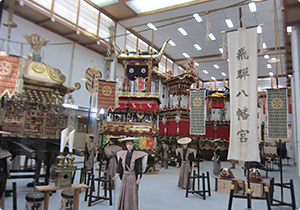
(Takayama Yatai Kaikan)
The Hall is in Sakurayama Hachimangu Shrine, and houses 11 floats for the fall Takayama festival. They rotate the floats 3 times a year (March, July, and November) putting 4 on display each time. Visitors can see them as they appear on the day of the festival.
The Takayama Festival actually composed of the spring festival (April 14th and 15th) and the fall festival (October 9th and 10th) ,and has registered as UNESCO’s Intangible Cultural Heritage in 2016.
【Access】Walk from Takayama Nohi Bus Terminal
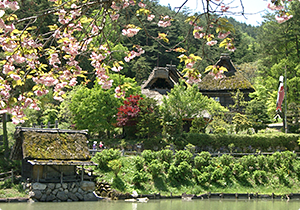
The village is an essential place to visit when you are in Takayama. More than 30 traditional buildings recreating Hida’s historical look. In each building, everyday articles recalling the life and culture of mountain farming villages are displayed. All could be entered and explored as you like.
Demonstrations of traditional crafts such as Hida lacquerwork, weaving and dyeing are held in arts and crafts centers. And you can make Hida folk art like straw crafts and sashiko quilting.
The season of autumnal leaves and in winter, light-up of private houses also spreads fantastic scenery.
【Access】Take Sarubobo Bus and get off at Hida no sato(Hida Folk Village)
Okuhida Onsengo
From Shinjuku; take “Hida Takayama Line” on Chuo highway bus, get off at Hirayu-Onsen. For Shinhotaka Ropeway and Other Spa Villages, take route bus from Hirayu-Onsen.
- Reservation for Highway bus ”Hida Takayama Line” from here (Highway-buses.jp)
- Information about route bus for Shinhotaka Ropeway and Other Spa Villages from Hirayu-Onsen (Nohi bus)
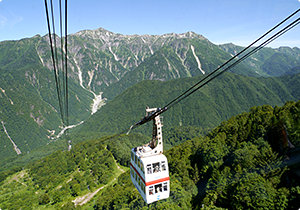
Shinhotaka Ropeway consisting of 2 ropeways is to Nishihotakaguchi, summit station at 2,156 meters above sea level. From observation deck on the roof of the Station, you can see the majestic mountains of the Northern Alps such as Nishi Hotakadake and Yarigatake Mountain etc. The gondola of No.2 ropeway is the only double decker gondolas in Japan.
【Access】Take the bus for Shinhotaka Ropeway from Hirayu-Onsen and get off a Shinhotaka Ropeway
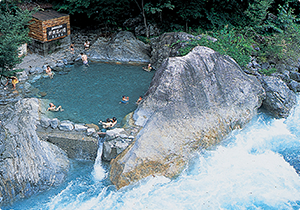
Oku-Hida Spa village (Okuhida Onsengo) is the collective name of 5 spa areas settled among the Northern Alps, Hirayu Spa area, Fukuji Spa area, Shin-Hirayu Spa area, Tochio Spa area, Shinhotaka Spa area. Each spa offers its own unique charms. It’s famous for the abundant amount of hot water springs, and the largest numbers of open air spas in Japan.
【Access】Take the bus for Shinhotaka Ropeway from Hirayu-Onsen
Norikura
From Shinjuku; take “Hida Takayama Line” on Chuo highway bus, get off at Hirayu-Onsen and take a route bus for Norikura
- Reservation for Highway bus Hida Takayama Line from here (Highway-buses.jp)
- Information about route bus for Norikura from Hirayu-Onsen. (Nohi bus)
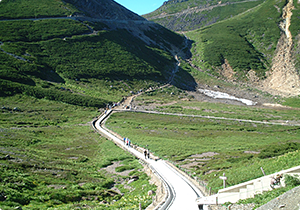
Located at the southern tip of the Northern Alps, this high area consisting of 23 ridges is collectively referred to as Mt. Norikura. The highest point is the Kengamine pinnacle, 3,026 meters above sea level.
Although Tatamidaira (2,702 m) is the highest point in Japan where cars can pass, you need to take a bus or a taxi to get there in order to protect the natural environment. Tatamidaira is the base for climbing Kengamine (takes 90 minutes to climb). In addition, the flower garden spreads below and you can enjoy alpine plants from the well-organized boardwalk. Tourist season is from May 15th to October 31st.
【Access】Take the bus for Norikura-Tatamidaira from Hirayu-Onsen, get off at Norikura-Tatamidaira.
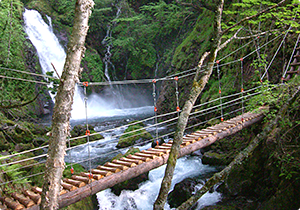
Goshikigahara Plateau is a vast woodland area of about 3,000 hectares, which is still covered by virgin forest. To take part in any of the organized tours, a reservation is necessary. Accompanied by a paid guide, you can follow the tracks through the forest while receiving information on the plants and other natural features of the surroundings.
【Access】Take the bus for Takayama Nohi Bus Terminal from Hirayu-Onsen, get off at Honokidaira.
Shirakawa-go・Gokayama
From Shinjuku; take “Hida Takayama Line” on Chuo highway bus, get off at Takayama Nohi Bus Terminal and take a route bus for Shirakawa-go.
- Reservation for Highway bus “Hida Takayama Line” from here (Highway-buses.jp)
- Information about route bus for Shirakawa-go from Takayama Nohi Bus Terminal (Nohi bus)
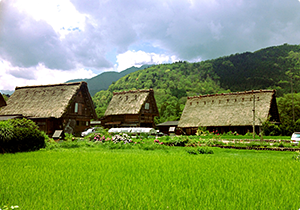
Shirakawa-go was registered as a World Cultural Heritage site in 1995. The distinctive large roofed gassho style houses are located in Ogimachi district, and there are about 150 buildings which are preserved in their original form since around 1800. The village spreads out across the landscape below the observation areas on the north side, it is great to overlook the gassho style houses gathered below in the settlement of Ogimachi.
【Access】Walk from Shirakawa-go Bus Terminal
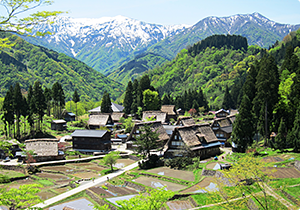
It was registered as a World Heritage Site as “Historic villages of Shirakawa-go and Gokayama”. There are 23 gassho style houses in Ainokura village and 9 houses in Suganuma village.
【Access】Take the bus for Takaoka Station from Shirakawa-go Bus Terminal, get off at Suganuma or Ainokuraguchi.
Hida Furukawa
Hida Furukawa is famous for its beautiful townscapes. Along the Seto-gawa, an artificial waterway, you will see the white walled storehouses on their right and turtle-shaped sculpture just under the roof top of the temple, Enko-ji, to their left.
It is also known for skillful woodworkers and carpenters. Traditional architectural style such as bay windows and lattice can be seen throughout the town. You will find traditional crafts shops such as Japanese candles and Hida Shunkei lacquer around this town.
From Shinjuku; take “Hida Takayama Line” on Chuo highway bus, get off at Furukawa Station. Or get off “Hida Takayama Line” at Takayama Nohi Bus Terminal, and take the route bus for Furukawa Station, get off at Furukawa Station
- Reservation for Highway bus “Hida Takayama Line” from here (Highway-buses.jp)
- Information about route bus for Furukawa Station from Takayama Nohi Bus Terminal. (Nohi bus)
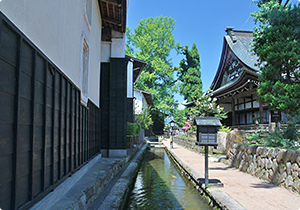
Along the Seto-gawa river, an artificial waterway flowing in the center, there are the white walled storehouses and turtle-shaped sculpture just under the roof top of the temple in the background. In Seto-gawa river, more than 1,000 colorful carp are swimming calmly in the waterway. In the traditional town, you can take a stroll, or visit sake brewery or candle shop.
【Access】Walk from Furukawa Station
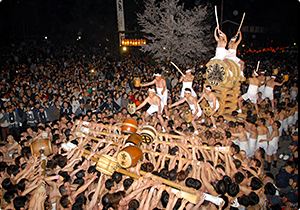
In Hida Furukawa Festival Hall, it has 3D movie of Furukawa Festival and diplays three real Yatai floats and the portable shrine, you can experience the taiko drumming trial and also a small glimpse of the festive atmosphere of the Furukawa Festival. Furukawa Festival registered with UNESCO Intangible Cultural Heritage.
【Access】Walk from Furukawa Station
Gero-onsen
From Shinjuku; take “Hida Takayama Line” on Chuo highway bus, get off at Takayama Nohi Bus Terminal and take a route bus for Gero-onsen.
- Reservation for Highway bus “Hida Takayama Line” from here (Highway-buses.jp)
- Information about route bus for Gero-onsen from Takayama Nohi Bus Terminal. (Nohi bus)
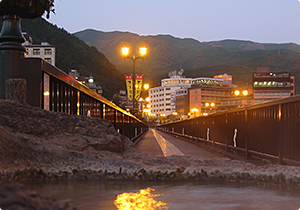
Gero Hot Spring (Gero-onsen) is considered one of the three most famous hot springs in all of Japan. It is particularly famous for the incredibly smooth spring quality, which makes the skin of those who soak in it just as smooth! This “spring of beauties” attracts people from all over the world, and once they experience the spring of Gero, they find it difficult to settle for anything else!
【Access】Walk from Gero Station
Nakatsugawa City
From Shinjuku; take “Shinjuku – Nagoya line” and get off at Magome (Magome-juku) or Nakatsugawa (Interchange).
It is approximately a 15-minute walk from the “Chuodo Magome” bus stop to the entrance of Magome-juku.
Reservation for Highway bus “Shinjuku-Nagoya” from here (Highway-buses.jp)
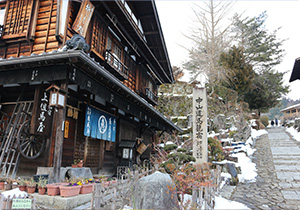
Magome-juku is a post town on the Nakasendo along the cobbled slope. The old town-scape is restored on both sides of the slope. Souvenir shops and old-fashioned cafes are lined up, and you can enjoy the nostalgic town-scape while eating, walking and shopping.
It is a 3-hour slow walk of an approximately 8 km from Magome-juku to the next Tsumago-juku. It is a popular hiking trail.
【Access】Approximately 15 minutes on foot from Chuodo “Magome” Bus stop to the entrance of Magome-juku.
